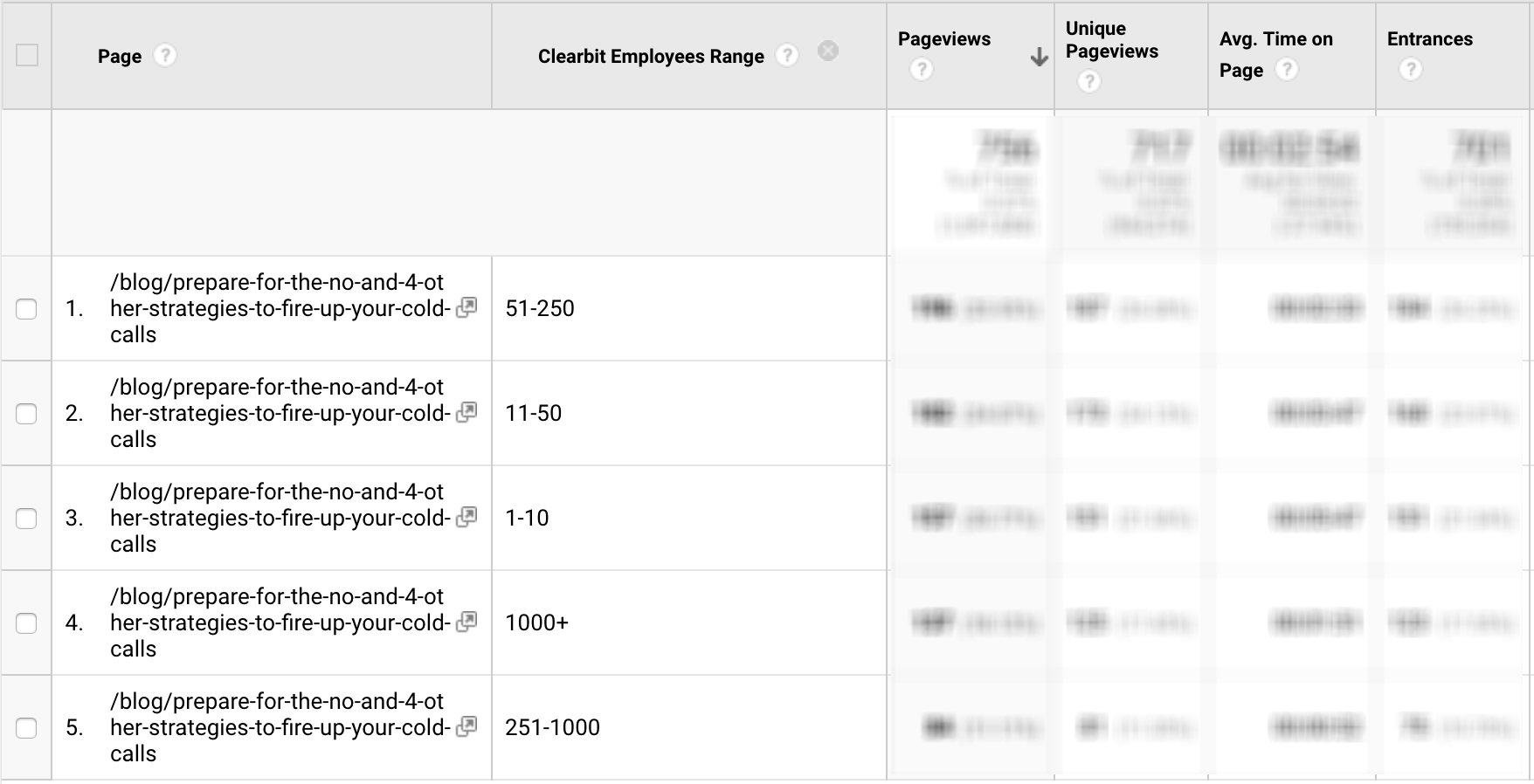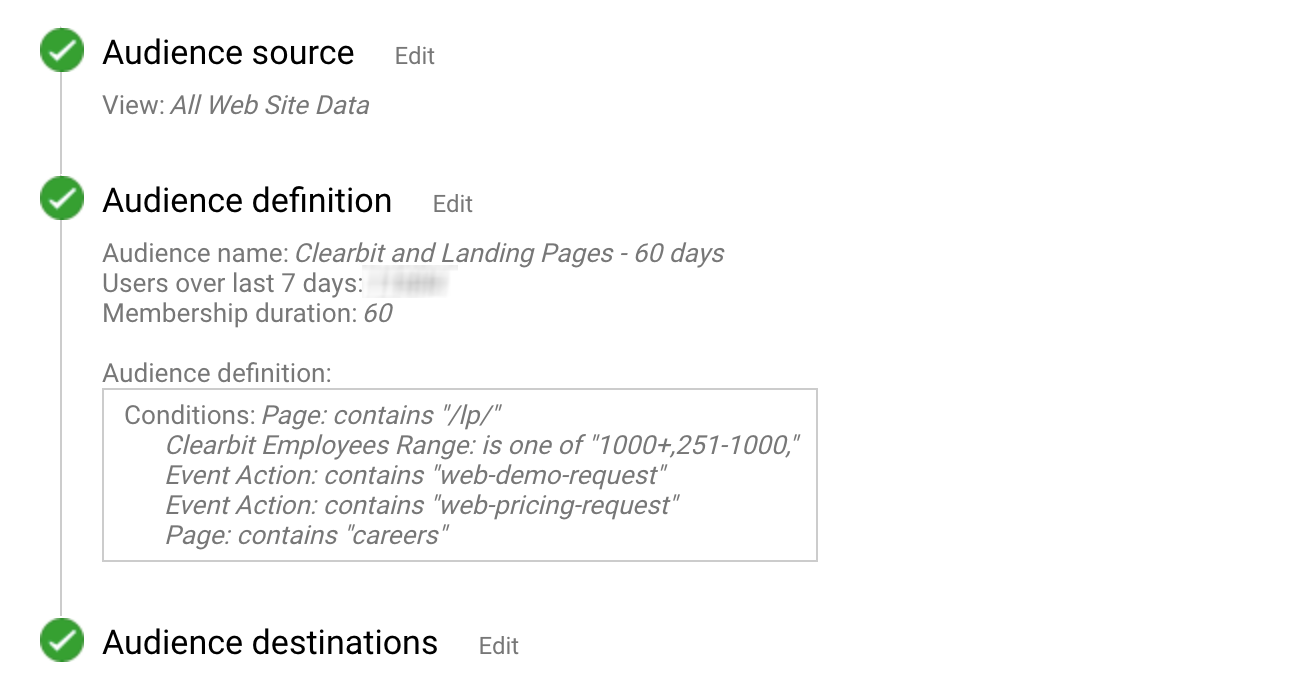How to identify anonymous website visitors and personalize your retargeting
Segmentation is a marketing basic. Most B2B companies spend a lot of time tailoring landing page copy, emails, ads, content, and phone calls—and proceed with extra care for high-value prospects.
But this rarely extends to retargeting, where the most common approach is to just hit the switch and follow as many people around the internet as possible.
Today we’ll show you how to properly retarget your high-value site visitors using segmented, personalized, and optimized ads that are more likely to be relevant for them.
If you’ve struggled with this, you’re probably bumping up against the blind spot of anonymous website visitors: it’s hard to segment an online audience when over 90% of B2B website visitors are unidentified. So the first step is to fix the anonymity problem by adding Clearbit Reveal to Google Analytics. This looks up anonymous visitors by IP address and adds rich firmographic data to help with segmentation.
The second step is to use Clearbit attributes to optimize remarketing campaigns, focusing them on high-value site visitors and personalizing ads.
Let’s start by looking at a company that uses Reveal in Google Analytics to understand their website traffic.
Step 1: See who your website visitors really are with Clearbit Reveal in Google Analytics
Outreach sells sales enablement software. One key attribute of their ideal customer profile (ICP) is employee size: they focus on midsize companies with 50-250 and 250-1000 employees, with less emphasis placed on other segments and no attention paid at all to tiny companies with 1-10 employees.
Outreach’s Director of Demand Gen, Dan Ahmadi, wanted to know how much of their website traffic included those target employee bands.
They added Clearbit Reveal to Google Analytics, which identified their site visitors and pulled in firmographic data that Analytics lacks by default, such as number of employees, industry, vertical, location, and technologies used.
Now that they had supercharged Analytics, they segmented all organic web traffic by Clearbit employee range to see whether they were attracting the right sizes.
Below you can see that their two target groups sit at the top: 51-250 employees and 251-1000 employees (we’ve masked the percentage breakdowns for confidentiality).

Outreach segments their site traffic in Google Analytics using Clearbit Employees Range.
Now that they’d confirmed that target prospects were visiting, they could find out what they were interested in—which pages they were visiting, what actions they were taking, and so on. For example, they wanted to see which blog posts attracted the valuable readers, so they broke down organic traffic to individual blog posts by Clearbit Employees range.
They saw that 30% of the readers for this post on cold calling best practices were in the 51-250 employee range. Bingo. Looking at the traffic breakdown, they knew this topic was a good one for their ICP.

Dan’s team can now do side-by-side comparisons of blog posts, double down on good topics, and stop using unsuccessful ones that might get a lot of general traffic but very little attention from high-value prospects.
This Analytics exercise can be repeated with other Clearbit company attributes that define an ICP, such as industry.
It provides a deeper way to understand your website audience and what your most valuable prospects are doing on your site, as opposed to an analysis that gives every visitor equal weight. For more examples of how to use Clearbit in Google Analytics, check out how another company, Outshine, uses it to create custom reports.
Once you have this intelligence, you can use it to optimize retargeting.
Step 2: Strategically retarget your high-value website visitors
No more blind, generic retargeting, ok? Here’s how to focus it on valuable site visitors only and personalize ads for different segments.
We’ll demonstrate with the Outreach example. They limit their retargeting to website visitors that fall into their target employee-size bands, excluding others. Here’s an example of a remarketing campaign aimed at people who’ve visited certain Outreach landing pages and are in either the 251-1000 or 1000+ employee range.

Let’s take a closer look at that audience definition:
Visitors to landing pages (URL contains “/lp/”)
Employee range:
* 251-1000 employees
* 1000+ employees
Exclude visitors that have taken actions: “web-demo-request” and “web-pricing request”
Note that it excludes visitors who’ve requested a demo or pricing information in the past, since they’re already in the sales pipeline.
That’s just one example, but all of Outreach’s remarketing campaigns exclude visitors with 10 or fewer employees, as well as visitors without Clearbit employee data on file, because the absence of that data reduces the chance that they’re a marketable company.
Another important point is that they bid more on certain segments. “We make sure that we’re investing our budget in the segments that are of the highest value to us,” says Dan. “The higher your employee range, the higher bid multiplier we set in our ad platforms.”
The result? Outreach found that campaigns guided by Clearbit data in Google Analytics outperformed others by 100%.
Outshine, like Outreach, has seen their bottom-of-funnel offers converting 215% higher on Clearbit-identified traffic now that they only remarket to website visitors with Clearbit data and actively stopped retargeting bad leads.
As Andrew Breen, President at Outshine, puts it, “At the enterprise level, there may be multiple definitions of what a good lead is ... but there is almost always consistent agreement on what a bad lead looks like.”
Cutting them out will save you some budget and protect your brand from annoyance at irrelevant ads.
In another example of optimized retargeting, Clearbit takes it a step further and customizes ads for different segments.
Here’s an example. In Analytics, we can segment our website visitors by industry or detailed vertical tags. Then we can tell Adwords to serve up slightly different remarketing ads for each industry:

We can also segment our retargeting using Tech Tags, which is a Clearbit attribute that indicates which software a company uses already and which we may integrate with. Our remarketing ads can point out to the visitor that Clearbit is compatible, and might look different for someone who uses Salesforce versus Marketo:

Or, if Tech Tags detect that a website visitor uses a competitor’s software, we can show retargeting ads that specifically address common pain points for that competitor . . . and hopefully get the visitor to consider switching.
When we know who’s really coming to our site, we can follow up with more care and intention. Clearbit Reveal in Google Analytics makes nearly all website traffic addressable—anonymous or not—and lets us split out the good leads for optimized retargeting. The days of spray and pray retargeting are over.
Want to supercharge your analytics and retargeting with Reveal? Request a demo.

